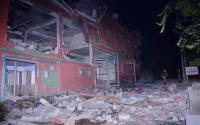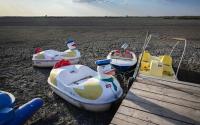The first thing we noticed was the blue ice melting.
My husband and I traveled to the Pacific Northwest last month, and one day found ourselves standing on top of a huge mountain of frozen cold, the Athabasca Glacier. Underneath our feet was a 1,000-foot-high pile of pressurized crystal, just one of many glaciers stretching out, like solid rivers of white, from the vast Columbia Icefield in Alberta, Canada.
What were we hearing as we stood on that ice roof? The sound of melting, as the purest substance known to humankind transformed from ice to liquid in rivulets all around us. We wandered along a luminescent blue creek that had formed right there on the glacier and tasted its waters. The sun was bright, despite the cold that emanated off the ice field, and the whole scene had an unworldly, make-believe quality to it, like something straight out of J.R.R. Tolkien's elf village of Rivendell.
But the melting was not make-believe. It was real and was not supposed to happening like that. Not at that rate. Not then and not for a very long time. Still, there it was taking place before our own eyes.
Many people visit glaciers these days to see for themselves whether the ice masses really are shrinking. It doesn't matter how many times they've seen the world's scientists line up and proclaim that the burning of fossil fuels enhances the greenhouse-gas effect, trapping heat in the atmosphere that really should be expelled. It doesn't matter because that's just a lot of words, too much science and, ultimately, too abstract for regular people to comprehend.
But once I'd stood on Athabasca, things were different. There was no more denying the truth of it: The glaciers were melting, the Earth was warming, and the danger to future generations is staggering.
Lisa, the young park guide, drove us – in a strange snow vehicle with huge tractor wheels – down a huge hill and out onto the vast white terrain of Athabasca, with its many crevices that opened deep, deep downward, farther down than the eye could see, into the huge body of ice. After a rugged and sloping journey, we got to the ice mass that existed below the vast white ice field. I asked her to explain to me about the retreat of the glacier, and she shrugged and said, point-blank, "Athabasca is melting."
Of course, it was summer, and a lot of glacier melt was expected that time of year. But the amount was a problem. It was too much, she said. The summer's melt wasn't supposed to be more than the winter's accumulation when taken overall. The glacier was supposed to balance out over the years and remain basically the same over the long haul. But it was not happening that way.
The glacier is disappearing.
Next, Lisa pointed up and over a vast moraine that towered hundreds of feet above where we were standing. Gesturing way up and over there, she explained how, about 30 years ago, the body mass of the glacier had stood way up there. "That's where Athabasca used to be," she said, indicating the distance with her hands.
That was when the enormity of what I was seeing really dawned on me.
One difficult thing to tackle in an essay about global warming is the still-widely held belief that's it's not really happening. Throughout the 1990s, scientific evidence piled up that documented the existence of the greenhouse-gas effect, caused by the use of fossil fuels, the destruction of forests and the release of industrial gases like chlorofluorocarbons. The studies found that these gases were causing the Earth to heat up. But a small number of scientists were unconvinced and believed the warming trend was part of a natural weather cycle that had occurred many times in history. The skeptics got a lot of attention – especially from politicians who didn't want to regulate or affect the oil and automobile industries and others – and basically stalled actions to solve the problem.
So, on the issue of global warming, a strange scientific disconnect arose between a handful of skeptics and the vast majority of scientists. For this reason, the National Academy of Scientists asked the United Nations to convene a panel of 2,500 scientists from around the globe to come to some conclusions about global warming once and for all. They formed the Intergovernmental Panel on Climate Change (IPCC) and, in 2000, arrived at the conclusion that yes, indeed, human actions – chiefly the burning of fossil fuels – were causing a global warming trend. The scientists further certified that this trend posed a serious threat to human well-being in the 21st century and surely would be accompanied by "a significant loss of life."
Somehow, even this proclamation from the world's top climatologists was dismissed by many, especially some in the U.S. government. When George W. Bush came into office as president, he immediately withdrew the United States from the Kyoto Protocol, the international community's first attempt to do something about global warming. Generally, Bush and his administration seemed to take an approach that science was an obstacle to growth and therefore bad for the economy and for America. (Interestingly, the retreat of glaciers, especially in the Arctic Barents Sea north of Russia, will make it easy to search for oil in regions that previously were impossible to explore.)
But the studies just kept rolling in. Last month, environmental scientists released one that countered the idea that the Earth is warming as part of a natural climate cycle. The study reinforced the IPCC report and found that the Earth is definitely warmer right now than it has been at any time in the past 2,000 years.
Still, the promise of the Kyoto Protocol remains unkept and largely ignored. Meanwhile, in the Pacific Northwest, the Cascade Range is disappearing. Mount Rainier's glaciers are shrinking. Montana's Glacier National Park soon will be glacierless, and the great ice masses in the Arctic and Antarctic are thinning. And nowhere are the glaciers melting faster than in the tropics. A recent Sierra Magazine article reported that in Tanzania, even the snows of Kilimanjaro are vanishing. "The mountain's ice field, which Ernest Hemingway called 'as wide as all the world, great, high and unbelievably white in the sun,' lost more than 80 percent of its area in the last century," read the story. "Within 15 years, it will be gone altogether." Indeed, though Athabasca might last another 100 or more years, many glaciers will be gone within 15 to 50 years.
What does all this melting portend? Throughout the next century, the Earth is predicted to heat up by 10.4 degrees Fahrenheit, causing extreme weather events to take place with increased frequency. Obviously, there always have been climatic events that have wreaked havoc on populations. But scientists say some of what's happening now is different, that we're going to be experiencing ever-more-extreme weather events like those in Europe this past summer, where the heat waves – accompanied by increased humidity and air pollution – wound up causing thousands of deaths in Italy and France.
Ultimately, there is little doubt that we are creating a future in which large portions of the Earth will be flooded routinely; huge storms regularly will cost thousands of lives and cause billions of dollars in damage; mass migrations will be likely; and famines and droughts will starve and kill large numbers of people, especially those living in the Third World.
Of course, these predictions – future famines, mass migrations – sound paranoid, like something from The X-Files, over-the-top and unimaginable. But if the world's scientists are comfortable proclaiming global warming as a fact that will have these consequences, why aren't we all ready to admit it?
The solution to the warming trend has been clear for a decade. We need to cut carbon-dioxide emissions dramatically, as was called for in the Kyoto Protocol. Governments must make a commitment to burn far less fossil fuels, to exhort automakers to build clean cars, and to greatly decrease industrial emissions that release chlorofluorocarbons.
Are individual citizens willing to play a role in helping slow the warming? On one hand, you can look at the proliferating sale of sport-utility vehicles (SUVs), with their gas-guzzling qualities, and think everything's going in the wrong direction, especially in America. On the other hand, in a recent poll by the Public Policy Institute of California, a vast majority of people – even a whopping 77 percent of SUV owners – were found to support taking steps to force automobile manufacturers to build more fuel-efficient cars. Obviously, California drivers are confident that the auto industry can produce the cars they want to buy while simultaneously burning less gas. And guess what? It can.
In Germany and Japan, automakers are introducing SUVs that burn far less gasoline. So, the technology is there. But the United States hasn't shown any indication that it will push for more such developments, what with the Bush administration arguing that, considering the economy, American auto companies can improve fuel economy only by a minuscule 1.5 miles per gallon in the coming years. Likewise, the technology exists to enable power plants to burn cleanly, but the Environmental Protection Agency recently proposed allowing ozone-depleting releases of almost 100 percent more than the current level. So, we're going backward, so far, on addressing the problem.
Part of me wanted to come home and tell people what I'd seen on that glacier. I wanted to urge people to buy clean cars and use their consumer clout to convince automakers to sell vehicles that get decent gas mileage. I wanted to shake the politicians by the shoulders and tell them to wake up, get smart and attack this problem. I wanted to go around quoting two-time Pulitzer Prize-winning scientist E.O. Wilson, who has said that the forces that are destroying the Earth and the people who can save it "have arrived together at this crossroads in history."
I wanted to believe something could halt the warming. I wanted to believe it wasn't too late.
To find out what you can do about global warming, check out www.sierraclub.org/globalwarming/tenthings.asp.






